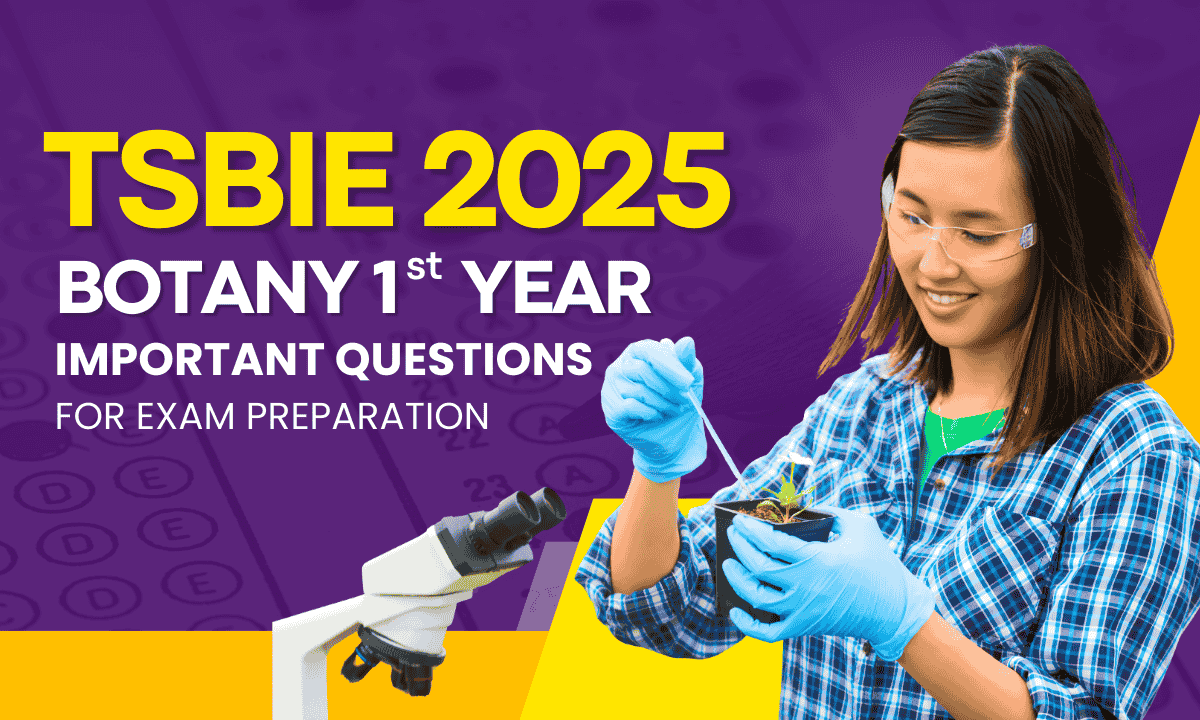Education
Telangana Intermediate 2025 Botany 1st Year Guess Paper for Exam Prep
Prepare your Telangana Intermediate 2025 Botany exam with this curated list of 60-marks practice questions. Master key topics for high scores!

With the Telangana Intermediate Botany 1st Year exams approaching in March 2025, students must focus on key topics outlined in the TSBIE syllabus. Below are 60-mark categorized questions to streamline revision and ensure thorough preparation.
Also Read: Facing issues Downloading Telangana Intermediate Hall Ticket 2025? Here’s Official Alternatives
Table of Contents
Very Short Answer Questions (2 Marks Each)
- What does ICBN stand for?
- Describe the nature of cell walls in diatoms.
- Name two diseases caused by mycoplasmas.
- Why is Mendel called the father of genetics?
- Define paleobotany and its significance.
- What is the basis for classifying algae?
- List stored food materials in Rhodophyceae and Phaeophyceae.
- Why are bryophytes termed “amphibians of the plant kingdom”?
- Explain the epipetalous condition with an example.
- What is parthenocarpic fruit? State its utility.
- Define heterospory. Name two spores in angiosperms.
- What is monosporic development of the female gametophyte?
- Identify three cells in a pollen grain at the three-celled stage.
- Define geocarpy. Provide an example plant.
- What does “S” signify in 70S and 80S ribosomes?
- Which DNA constituents are linked by glycosidic bonds?
- Which cell cycle phase is the longest?
- Name the pollination mechanism in Fabaceae.
- What is a satellite chromosome?
- Identify plants tolerant to sea salinity.
- Define population and community.
- Why do hydrophytes have reduced xylem?
- State the composition and function of the middle lamella.
- Differentiate heliophytes and sciophytes.
- Describe the morphology of the Cyathium structure and its family.
Short Answer Questions (4 Marks Each)
- Explain binomial nomenclature.
- Highlight key features of Euglenoids.
- Discuss the importance of Chrysophytes.
- Provide a brief account of Dinoflagellates.
- Compare red algae and brown algae.
- Differentiate homosporous and heterosporous pteridophytes with examples.
- Summarize gametogenesis with examples.
- Label haploid (n) or diploid (2n) for: ovary, anther, egg, pollen, male gamete, zygote, antipodal cells, megaspore mother cell.
- Define triple fusion and explain its process.
- What is apomixis? State its importance.
- Describe essential organs of Solanaceae.
- List the economic importance of Fabaceae plants.
- Explain the structure and role of the “powerhouse of the cell.”
- Define nucleosomes and their composition.
- Justify nucleic acids’ secondary structure with examples.
- Why is interphase not a “resting phase”?
- Identify locations and functions of meristem types.
- Differentiate lenticels and stomata.
- List morphological adaptations of hydrophytes.
- Enumerate anatomical adaptations of hydrophytes.
- Detail anatomical adaptations of xerophytes.
Long Answer Questions (8 Marks Each)
- Define root modification. Explain functional adaptations.
- Discuss stem modifications for varied functions.
- Describe types of racemose inflorescence.
- Draw and label a mature angiosperm embryo sac. Explain synergid roles.
- Illustrate a microsporangium’s structure and wall layers.
- Explain fertilization in angiosperms.
- Describe the transverse section (T.S.) of a dicot stem.
- Detail the T.S. of a monocot stem.
- Explain the internal structure of a dicot root.
- Discuss the internal structure of a monocot root.
- Outline post-fertilization changes in flowers.
Final Tips for Students
- Practice diagrams for long-answer questions, such as embryo sacs and stem/root sections.
- Focus on NCERT-based terminology for taxonomy and classification.
- Revise definitions and examples for algae, bryophytes, and angiosperm families.
By mastering these questions, students can confidently tackle the Telangana Intermediate 2025 Botany exam and secure high marks. For additional resources, refer to the TSBIE model papers and syllabus guidelines.
